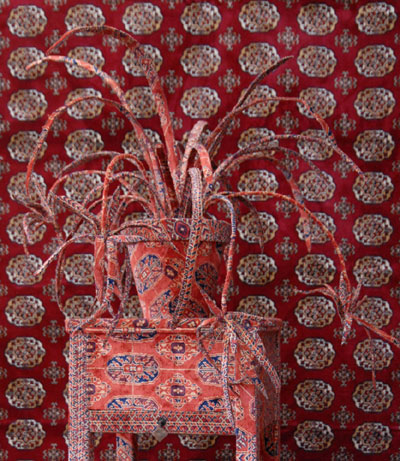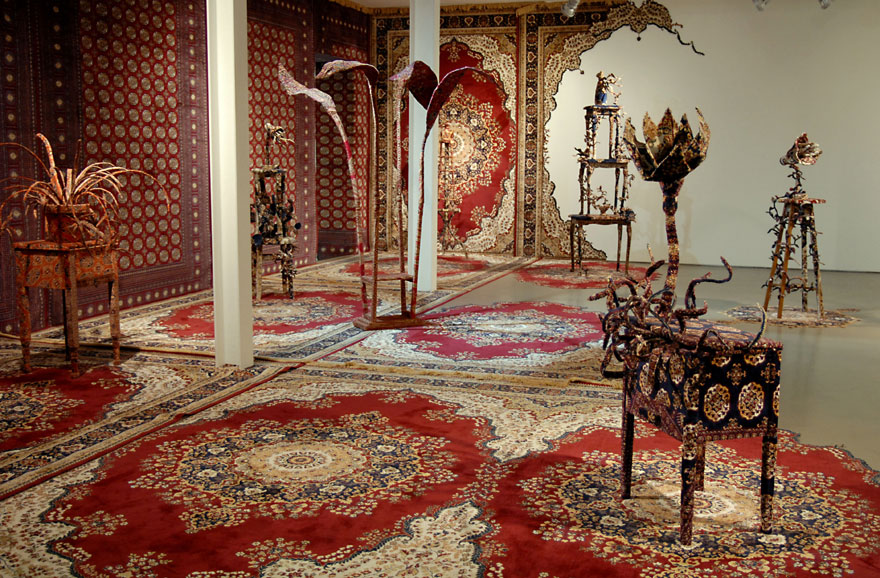| EXHIBITIONS NEWS PRESS ABOUT US CONTACT |
|||||
| REPRESENTED ARTISTS | BERTILLE BAK | GWENAEL BELANGER | DEXTER DYMOKE | ANTTI LAITINEN | |
| MARKO MAETAMM | YUDI NOOR | OLIVER PIETSCH | KIM RUGG | ||
| BETTINA SAMSON | SINTA WERNER | ||||
DEBBIE
LAWSON
Dysfuncadelia
10 OCTOBER – 16 NOVEMBER 2008
NETTIE HORN
is pleased to present Dysfuncadelia, the first UK solo show of artist
Debbie Lawson which features an elaborate installation of sculptural
works as well as a selection of inlaid wood panels.
Debbie Lawson creates atypical environments through the use of found
objects, household furniture and domestic materials such as “Persian”
carpet and wood. A new hybrid meaning is found in the use of these «
kitsch » materials in her sculptures and installations away from
their inherent decorative quality. Tinged by a collective and personal
nostalgia linked to memories of the domestic interior and suburban life,
these humdrum objects become part of a “mise en scène”
which is created thanks to the narrative formed by our own history
and memories. The encounter between the material and the object reveals
a dramatic other life according to what the artist saw as its own particular
aspirational quality.
For her solo exhibition,
Lawson turns both rooms of the gallery into two different environments
specifically created through the use of her materials of predilection.
Slowly growing into a jungle-house, the main room erupts into a lush
landscape of carpeted stacks dripping with leaves and smothered in all
kinds of fanciful flora made from different objects and furniture. Playing
on the idea of collision between heterogeneous elements, Lawson creates
an optical illusion through the association of a rhythmic pattern to
a three-dimensional form.

Spider, 2008, 'Persian' carpet and furniture
Gradually contaminating the space and invading the room, these personified hybrid plants create a new genre of the exotic in a dimensionally mutated space. These oversized plants, at once startling but also grotesque, reveal with humour a universe which sources its inspiration from suggestive and affective codes.
Her full size “wobbly”
triptych panel inlaid with marquetry subverts the polite associations
of a traditional craft into a warped landscape of wilted leaves.
Merged with the stuff that surrounds us, popular narratives and personal
histories are intertwined so that the imaginary and material reality
seem inseparable.

Dysfuncadelia, Installation view
Debbie
Lawson lives and works in London and graduated with an MA from the Royal
College of Art in 2004.
She is concurrently exhibiting "Chairway to Heaven"
at the Economist Plaza from 17 October - 28 November. Recent exhibitions
include East West Dialogues at LTMH Gallery, New York, USA; Interiors
at Imoderni, Miami, USA; Pilot 3 at the 52nd Venice Biennale; The Islanders
at NETTIE HORN, London; Arboreal at Transition gallery, London; Shibboleth
at Dilston Grove, London; Violin/Violence at 1,000,000mph gallery,
London.
By Peter Suchin
In the nineteenth century Edgar Allan Poe discoursed upon what he called the “Philosophy of Furniture”; today, in order to consider in depth the work of Debbie Lawson a psychology of furniture would be a necessary requirement. [1] One imagines that something a little more fine-grained than Gaston Bachelard’s “poetics of space” [2] might be a useful tool as well, an analytic method subtle enough to penetrate the niceties – though that is hardly the most appropriate term – of Lawson’s eerily engaging work. The necessary for the invention of new modes of analysis or critique is to be found within the framework that novel artistic entities help to produce and consolidate. Lawson’s practice, a modus operandi that is not easy to pigeonhole or classify, might be approached from several perspectives; the present essay cannot pretend to do much more than open up a few avenues of investigation into the artist’s work.
There’s something about the way Lawson produces and presents what she makes that is simultaneously attractive and mildly repugnant. The general “feel” of her installations is, at least at first regard, homely and warm, as though one has stepped into an English country house that is still occupied, lived in on a daily basis rather than having been remade as a museum piece or tourist spectacle. But the ambience is tainted with a sense of unease. The discrete features of the room – a panelled wall, lush carpeting, potted plants neatly arranged on period tables – turn out to be not so discrete or independent after all. Objects that are apparently coherent and stable merge or fall apart, slyly transforming themselves, behaving in an atrocious fashion considering the calm and expressly inanimate order with which we might normally expect them to comply. For furnishings do not, as a rule, penetrate the space of adjacent objects, their forms are fixed in place, predictable and reliable in their mutual coexistence. But in Lawson’s “eccentric spaces” (to borrow a term from Robert Harbison) the domestic framework she has constructed is destabilised, pulled apart from within itself. [3] One might recall in relation to this the much misused but important (and here more than mildly appropriate) concept and practice of Deconstruction, which is Jacques Derrida’s name for an almost shockingly prolific process of instability and self-critique. [4]
In Lawson’s work a kind of doubling or ghosting has taken place, the artist providing us with “sophistications of sophistications” [5], wherein a highly-desirable yet fairly prosaic object, a plush carpet or other semi-utilitarian prop, has undergone a further act of refinement, one that strictly goes against the grain of our received ideas of what these pseudo-luxurious things should be or do. That the source material is frequently suave, expensive and finely crafted is highly significant. Lawson, in redirecting and adding to the object’s physical structure, pushes it to the point of parody, in such a way that the intangible yet purportedly admirable attributes of the thing deployed – its charm, tastefulness or beauty – are downgraded and mocked. But this act is as much one of emphasising the innate qualities of the form as it is of physically disrupting it. Lawson may also make from scratch some of the things she presents; her wall panels, for example, are not found objects but are made outright by the artist, but in a way that deviates from the normal formal structure of such devices. The laborious action of manufacture is thus redirected, deliberately flawed from the start. A cartoon-like rendition of the wall replaces what such a wall might be and “do”. The living room – the phrase becomes almost literal here – enters the gallery space, transfigured, as it were, twice over, a caricature of the aesthetic ideals to which it directly alludes.
Whilst Lawson’s reinscriptions owe something to Surrealism, to reduce them to this category would be a mistake. They touch on much more recent concerns with originality, simulation, the model and the copy, as well as upon the nature of beauty as something that no longer dominates the field of art, at any rate not as a universally accepted quality or state. Perhaps there is something of Breton’s “convulsive beauty” visible within Lawson’s work but this is but one touchstone amongst many others. [6] Where nature and artifice begin and end, or whether we can any longer determine their point of difference and intersection is yet another issue Lawson raises. The purportedly inorganic entities featured in her mock-bourgeois tableaux have, it would appear, lived a life of action out of sight of the viewer. If, in the past, some of the artist’s work involved pieces with parts that actually readjusted themselves in proximity to the individuals present before them, in her recent installations Lawson has not allowed the viewer to witness the slipping and sliding of parts; or rather, the movement of a plant constructed from a Persian carpet is implied not actual, an effect that is arguably all the stronger for its encouragement of imagination and studied reflection.
The overall effect of Lawson’s constructed spaces is hallucinatory, an almost drug-like experience but enacted from the outside in. There are elements of kitsch, of a strayed Victoriana, a “palimpsestuous” layering of detail. The subject matter of the marquetry Lawson integrates within the panelling is incongruous, one more interruption of the mores of bourgeois good taste. [7] The power of Lawson’s work, its seductive but disorienting effect ultimately comes from a combination of the artist’s assiduous attention to detail whilst realising imagery that both draws one in and holds one back. “Dreaming the fantastic”, as Harbison has remarked, is not enough; “it must be lived.” [8]
Notes
1. See Poe’s
“The Philosophy of Furniture” (1840) in Edgar Allan Poe,
Selected Writings, Penguin, 1980.
2. Gaston Bachelard, The Poetics of Space, Beacon Press, 1964.
3. Robert Harbison, Eccentric Spaces, Andre Deutsche, 1977.
4. See, for example, Jacques Derrida, Of Grammatology, Johns Hopkins
University Press, 1984.
5. Harbison, Eccentric Spaces, p. 153.
6. Andre Breton, Nadja, Grove Press, 1960, p. 160.
7. In these inlaid panels a refined technical procedure is employed
to present images of, amongst other things, copulation.
8. Harbison, Eccentric Spaces, p. 77.
© NETTIE HORN